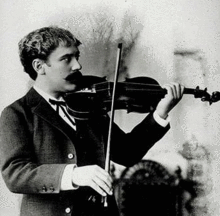2nd violin concerto (Bruch)
The Violin Concerto no. 2 in D minor op. 44 is a violin concerto from Bruch .
Emergence
The concerto was written in 1877, ten years after Bruch 's first successful violin concerto for the Spanish violinist Pablo de Sarasate . Bruch heard the violinist performing his (Bruch's) concert debut and decided to write a violin concerto especially suited to Sarasate's abilities; the violin concerto should be ready by the autumn of 1877, the violinist's next European tour.
In mid-October Bruch and Sarasate traveled to England, where Bruch's First Violin Concerto and the oratorio Odysseus were performed. The first performance of the Violin Concerto No. 2 in D minor op. 44 took place on November 4, 1877 in London's Crystal Palace with Sarasate as soloist and Bruch at the conductor's desk.
In contrast to the composition of the previous work, Bruch found his work easier this time, because the second concert gave him, as he wrote, “the courage to play instrumental music”. With regard to the client, Bruch wrote: "The main ideas of the work are products of the enthusiasm that its indescribably perfect rendering of the 1st concert aroused in me."
To the music
Sentence names
- Adagio non troppo
- Recitativo. Allegro moderato - Allegro - Andante sostenuto
- Final. Allegro molto.
description
In accordance with the skills of the virtuoso Sarasate, the violin concerto places high demands on the soloist.
The first movement is a funeral march accompanied by the plaintive violin. Despite Bruch's rejection of program music, Bruch's friend Wilhelm Altmann Bruch said that this sentence was inspired by a scenario by Sarasate, namely by the image of a woman looking for her lover between the corpses of fallen soldiers on the battlefield wandering around. The Adagio of the first movement breaks with the tradition of the allegro that is otherwise common in the first movement of a concert.
The second movement, an instrumental recitative, contains thematic recursions or anticipations of the corner movements of the concert and leads on to the finale. He is inspired by vocal music.
The third movement is a vital rondo finale.
effect
Despite Bruch's compositional efforts, his second concert - just like his third violin concerto written in 1890/1891 - is overshadowed by the success of the popular first violin concerto . After initially enjoying the success of the first violin concerto, Bruch felt it was a burden, as it diverted attention from Bruch's other compositions.
Johannes Brahms wrote to his publisher Fritz Simrock about the unusual structure of the concert with an adagio as the first movement : “We really liked the last movement of his concert and hopefully we don't need a Reich law to prevent the first movement from being written more often becomes. That is unbearable for normal people ”, to soften his judgment a little later:“ I was probably wrong about the effect of the Vruch concert. I didn't think the first sentence was very practical - a bit boring "
Critic Hans von Bülow - still in a frenzy of the First Symphony by Johannes Brahms, which was premiered in the same concert - judged Bruch's violin concerto severely: “Plump instrumentation, sloppy form, extreme poverty and chilliness of the basic ideas - good contrast between them and skillful work. In all technical matters one can regard Mr. Bruch as - so to speak, a reussed Hiller .... It was only since my knowledge of the tenth symphony, aka the first symphony by Johannes Brahms, so only for six weeks, that I have been so inaccessible and hard on Bruch pieces and the like. "
Bruch reacted angrily when at another concert on November 15 the Bonner Zeitung practically completely ignored the violin concerto and instead devoted itself entirely to Brahms' symphony.
literature
- Christopher Fifield: Max Bruch - Biography of a Composer , Swiss publishing house, 1990 Zurich, ISBN 3-7263-6616-4 , pp. 147–154
- Harenberg concert guide , Harenberg Kommunikation, Dortmund, 1998, ISBN 3-611-00535-5
- Booklet of the double CD Bruch - The Complete Violin Concertos , Philips Classics, 1998
Web links
- 2nd Violin Concerto (Bruch) : Sheet music and audio files in the International Music Score Library Project

